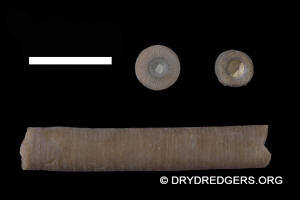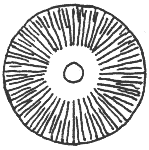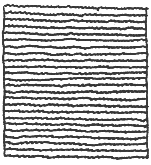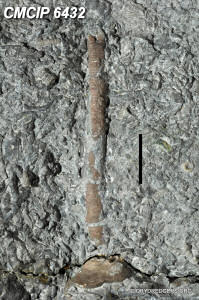A Beginners Guide To Identifying
Cincinnatian Crinoids
By Jack Kallmeyer
Inadunata - Cladida
Cupulocrinus polydactylus
Dendrocrinus caduceus
Merocrinus curtus
Plicodendrocrinus casei
Crinoid Anatomical Glossary
Return to Crinoid main page
Cupulocrinus polydactylus
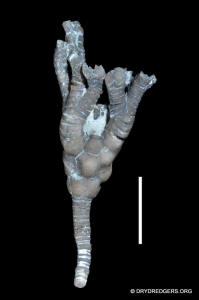 
10 mm scale
Photos by Jack Kallmeyer |
Cupulocrinus polydactylus is easily
identified by the smooth convex nature of the cup plates giving it the
appearance of a bunch of grapes. C. polydactylus
has a conical cup with thick arms supported by wide radial plates. The
arms are non-pinnulate and divide multiple times above the cup.
The stem is round in cross-section and tapers gradually beneath the cup.
Stem length is presumed to be quite short, less than 100 mm, based upon
species of Cupulocrinus found in other
parts of the country.
C. polydactylus
is found in the Waynesville, Liberty and Whitewater Formations.
See photos of Cupulocrinus
specimens found on Dry Dredgers field trips. |
Dendrocrinus caduceus
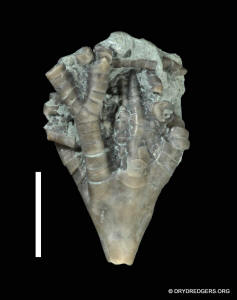
10 mm scale
Photo by Jack Kallmeyer |
Dendrocrinus caduceus has a somewhat
conical smooth cup. The cup displays three dimples around the middle.
The arms are narrower than the radial cup plates to which they attach.
The anal sac is large and consists of smooth plates
near the top of the cup becoming more ornate distally.
The stem
is round in cross-section and tapers beneath the cup.
Dendrocrinus caduceus is found in the Waynesville and
Liberty Formations. |
Plicodendrocrinus casei
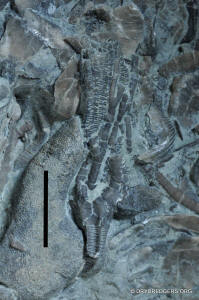
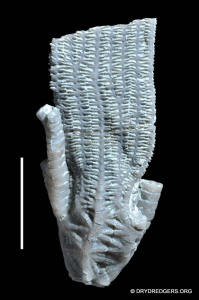
10 mm scale
Photos by Jack Kallmeyer |
Adult Plicodendrocrinus cups are highly
ornamented with prominent ridges. Small individuals lack these ridges.
The non-pinnulate arms branch twice above the cup. The arms are narrow,
being narrower than the radial plates of the cup to which they attach.
The arm cross-section is somewhat cuneiform.
The prominent
anal
sac is very distinctive in this species. The sac is large, at least ten
times the height of the cup, and ornamented with stellate ridges. This
anal sac morphology is apparent even in small individuals.
Plicodendrocrinus casei is found in the
Waynesville and Liberty Formations.

10 mm scale
Photos by Jack Kallmeyer |
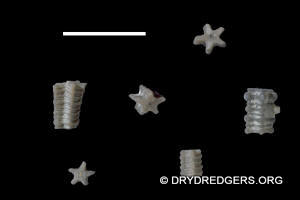
10 mm scale
Photos by Jack Kallmeyer |
 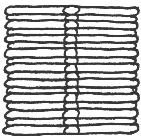
The stem of P. casei is stellate in cross-section
with faint articulating ridges. The stem tapers below the cup. The
morphology of P. casei
columns shows an
ability to allow a small amount of twisting. In general, twisting of
crinoid columns is
restricted by interlocking grooves and ridges to
prevent the column from breaking from torsional forces. Discovery of
this capability in P. casei is unique among
crinoids. |

5 mm scale
Photos by Jack Kallmeyer |

The anchorage method is via
radicular cirri emanating
from the distal stem allowing the crinoid a means of attachment in soft
sediments. This form of attachment was rare among Ordovician crinoids. |
Crinoid
Anatomical Glossary
The Dry Dredgers and individual contributors reserve the
rights to all information, images, and content presented here. Permission to
reproduce in any fashion, must be requested in writing to admin@drydredgers.org
www.drydredgers.org is designed and maintained by Bill Heimbrock.





